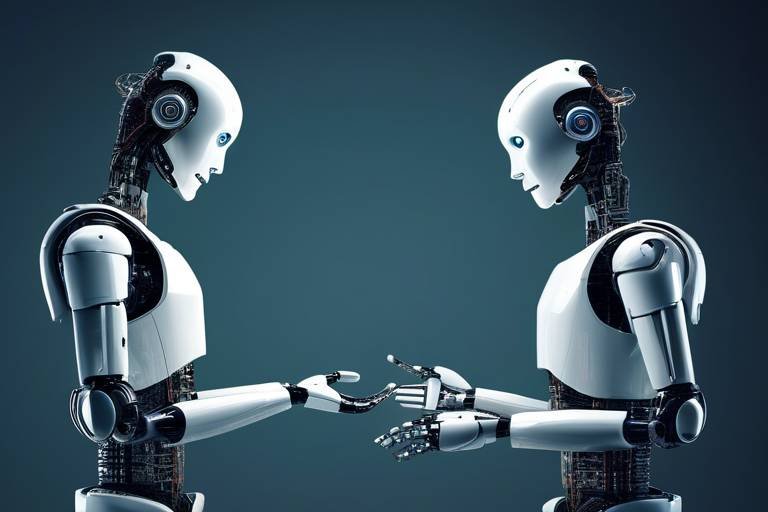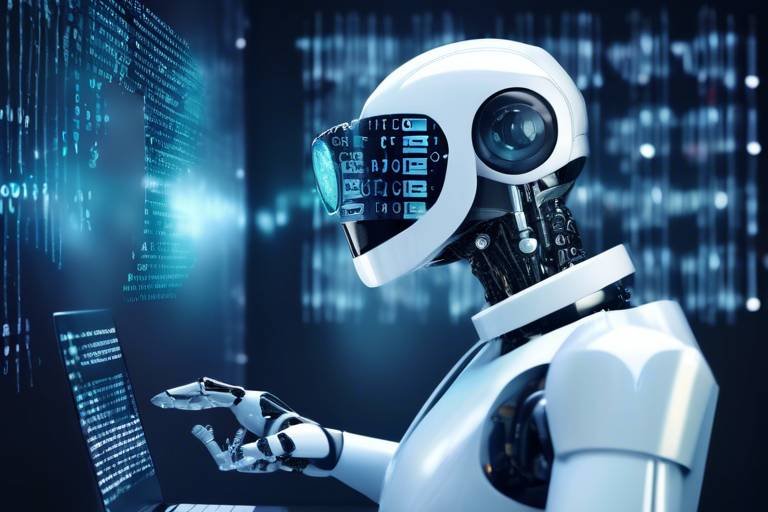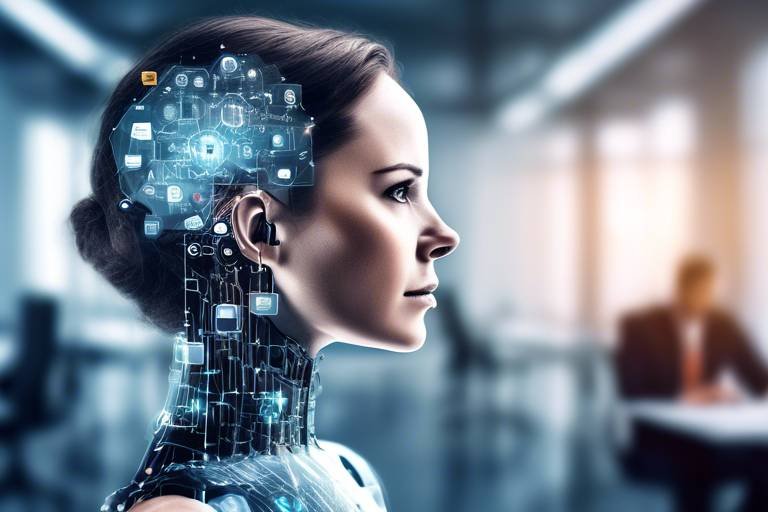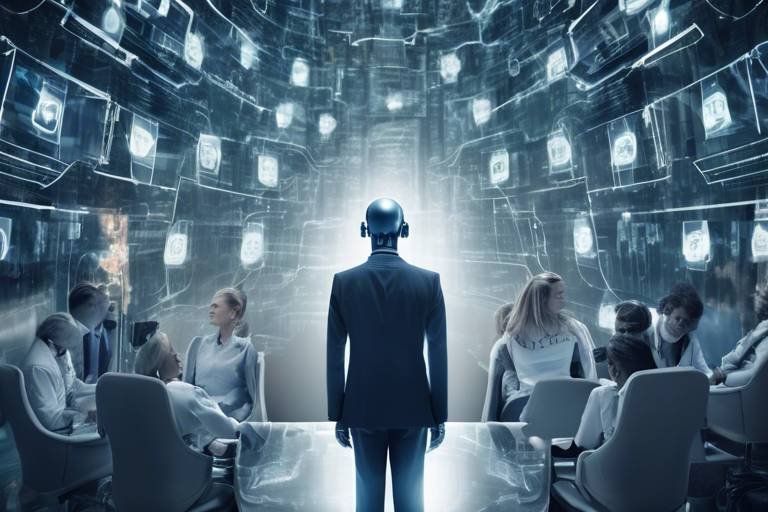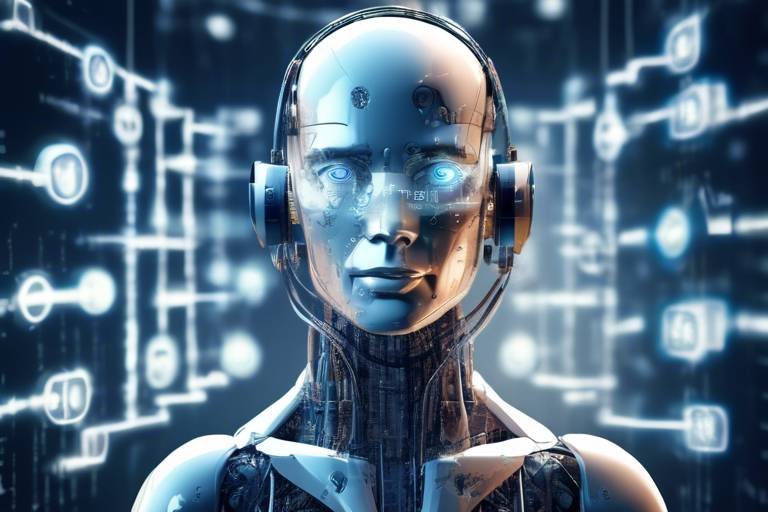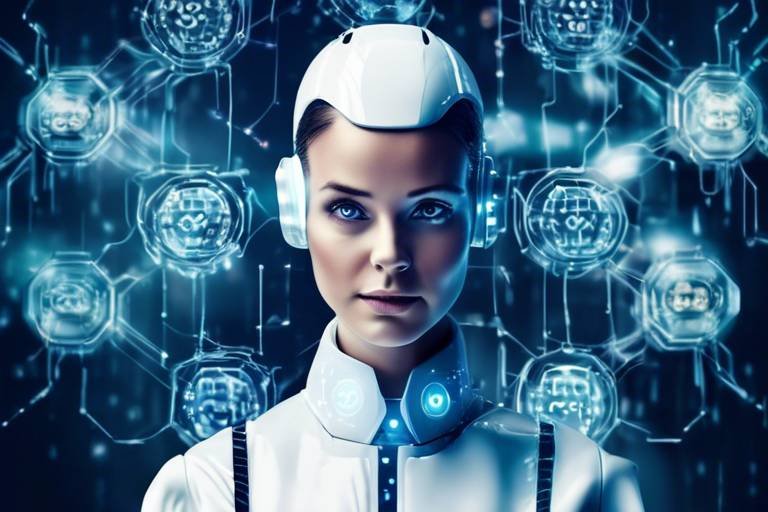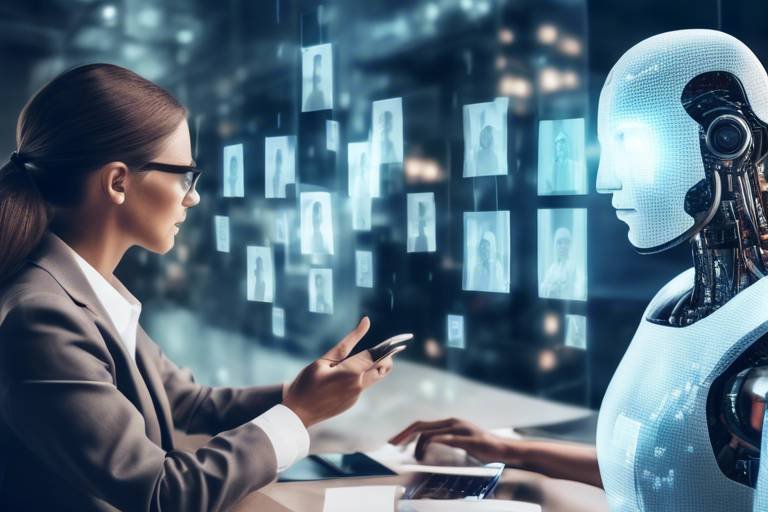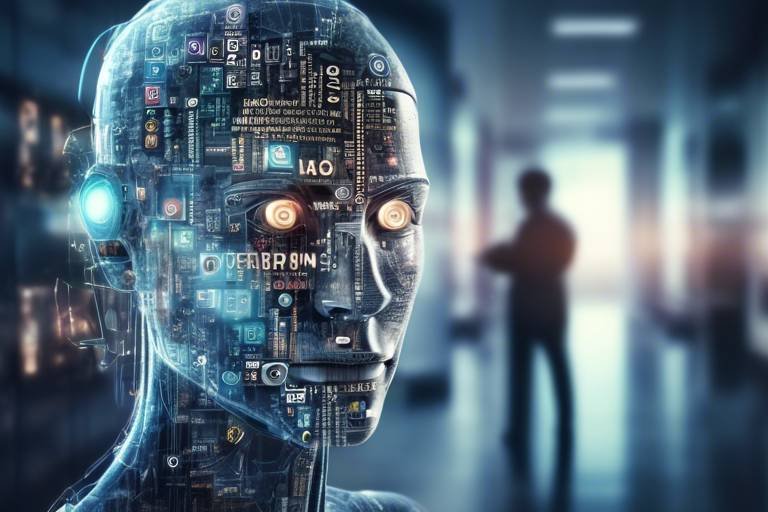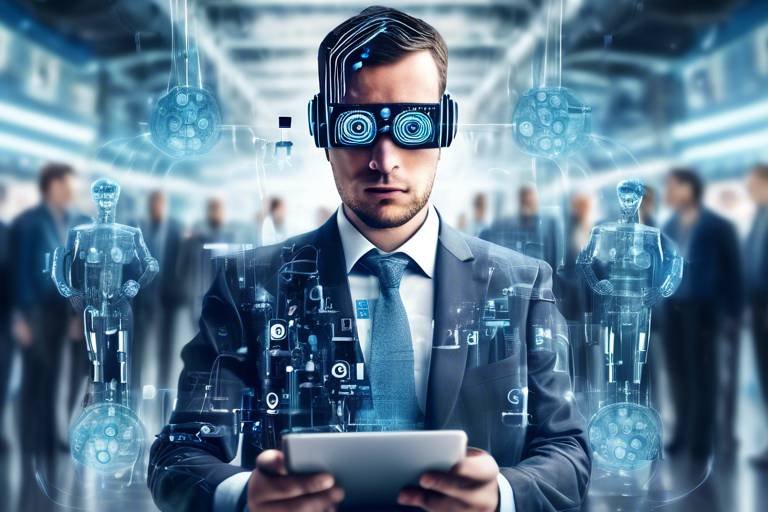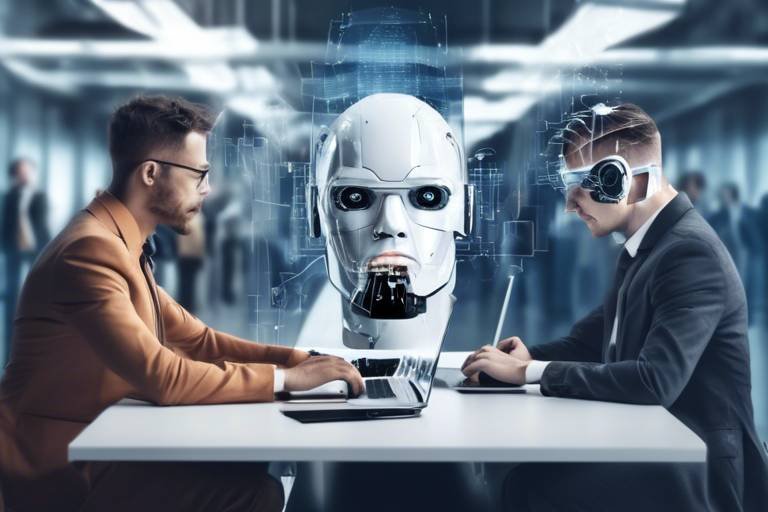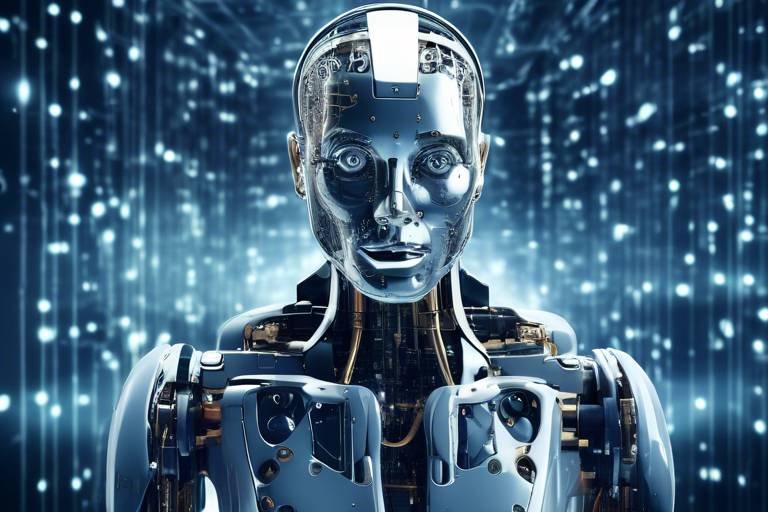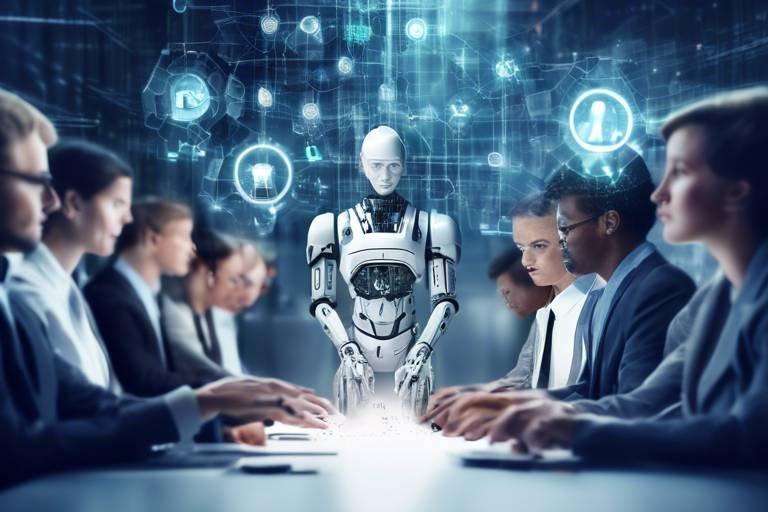Future Work Ethics: AI, Robots, and Society
The rapid advancement of technology, particularly in the realms of artificial intelligence (AI) and robotics, is transforming the very fabric of our workplaces. As we stand on the brink of this new era, it’s crucial to examine how these changes will shape our work ethics and societal norms. The integration of AI and robots into various industries promises to enhance efficiency and productivity, but it also brings forth a myriad of ethical dilemmas that we must address. Are we prepared for a future where machines not only assist us but also challenge our roles? This article explores the evolving landscape of work ethics amidst these technological advancements, delving into the implications for society and the workforce of the future.
As AI technologies advance, their influence on job markets grows exponentially. We are witnessing a shift where traditional roles are being redefined, and new opportunities are emerging. For instance, industries like manufacturing and customer service are increasingly relying on AI-driven solutions to streamline operations. But what does this mean for the workforce? While some jobs may vanish, others will require new skill sets that align with the capabilities of AI. Workers must adapt to this changing landscape, embracing lifelong learning to stay relevant. The emphasis on digital literacy and technical skills will be paramount as we navigate this transition.
Automation raises significant ethical questions that society must grapple with. When machines take over tasks traditionally performed by humans, we must consider the moral implications of such replacements. Are we sacrificing the dignity of work for efficiency? Companies have a responsibility to ensure that their transitions to automated systems are not only financially sound but also ethically justified. This means being transparent about their processes and considering the impact on their workforce. The challenge lies not just in adopting new technologies, but in doing so with a sense of corporate responsibility and ethical foresight.
Job displacement due to automation is a pressing issue that cannot be ignored. As machines take over more tasks, the risk of unemployment rises. However, it’s not just about losing jobs; it’s about finding ways to help displaced workers transition into new roles. Companies and governments must collaborate to develop effective retraining programs that equip individuals with the skills needed in an AI-driven economy. For example, initiatives could include:
- Workshops on digital skills
- Partnerships with educational institutions for upskilling
- Incentives for companies that actively retrain their workforce
By investing in human capital, we can ensure that workers are not left behind in this technological revolution.
Effective government policies are essential for workforce transition. Policymakers must create frameworks that support workers affected by automation. This could involve:
- Providing unemployment benefits for displaced workers
- Funding retraining programs
- Implementing tax incentives for companies that prioritize human employment
Such measures will not only help individuals but also foster a more resilient economy as we adapt to the changes brought about by AI and robotics.
Corporations play a crucial role in ethical automation. As they adopt new technologies, businesses must take responsibility for their workforce. This involves not just minimizing job losses but also ensuring fair practices during technological transitions. Companies should strive to create an environment where employees feel valued and supported, even in the face of automation. This commitment to ethical practices can enhance brand loyalty and public trust, ultimately benefiting the organization in the long run.
As AI systems become integral to hiring processes, the issue of bias becomes increasingly pertinent. Algorithms can inadvertently perpetuate existing biases, leading to unfair hiring practices. It is essential to address these biases to ensure fairness in hiring and promote diversity in the workplace. Companies must prioritize the development of unbiased AI systems and regularly audit their algorithms for fairness. This commitment to ethical hiring practices not only benefits job seekers but also enriches the organizational culture.
In an automated world, human oversight remains vital. While AI can process data and make decisions at lightning speed, the need for human judgment in decision-making processes cannot be overstated. There are nuances in human behavior and ethics that machines simply cannot replicate. Therefore, maintaining a balance between AI efficiency and human intuition is crucial for sustainable progress. This collaboration can lead to innovative solutions that maximize productivity while upholding ethical standards.
The future of work may involve a harmonious collaboration between humans and AI. Imagine a workplace where AI handles mundane tasks, allowing humans to focus on creative and strategic endeavors. This partnership can enhance productivity and job satisfaction. However, it is essential to establish guidelines that ensure this collaboration adheres to ethical standards, prioritizing the well-being of the workforce.
Trust in AI systems is essential for their acceptance in society. To build public confidence, organizations must be transparent about how AI technologies are deployed and the ethical considerations involved. Strategies such as involving diverse stakeholders in the development process and conducting regular audits can help ensure that AI systems are fair and accountable. By fostering trust, we can create a future where AI is seen as a valuable ally rather than a threat.
1. What are the main ethical concerns regarding AI and automation?
The primary concerns include job displacement, bias in AI algorithms, and the responsibility of companies to support their workers during transitions.
2. How can workers prepare for the changes brought by AI?
Workers can enhance their digital literacy and seek retraining opportunities to acquire skills relevant to the evolving job market.
3. What role do governments play in addressing job displacement?
Governments can implement policies that support displaced workers, such as funding retraining programs and providing unemployment benefits.
4. How can companies ensure ethical practices during automation?
By prioritizing transparency, providing support for affected employees, and actively working to eliminate bias in AI systems.

The Impact of AI on Employment
As we stand at the precipice of a technological revolution, artificial intelligence (AI) is reshaping the very fabric of our job markets. Gone are the days when machines were mere tools; they are now becoming integral partners in the workforce. This shift brings about a myriad of opportunities and challenges that can leave many scratching their heads. How exactly is AI influencing employment, and what does this mean for the future of work?
To understand the impact of AI on employment, we first need to consider the types of jobs that are being transformed. Some roles are being completely automated, while others are evolving into hybrid positions that require a blend of human and machine skills. For instance, in sectors like manufacturing and logistics, robots are taking over repetitive tasks, allowing human workers to focus on more complex and creative responsibilities. This shift can lead to increased productivity and efficiency, but it also raises questions about job security and the need for new skill sets.
According to a recent report by the World Economic Forum, it is estimated that by 2025, 85 million jobs may be displaced by a shift in labor between humans and machines. However, the same report anticipates that 97 million new roles could emerge that are more adapted to the new division of labor. This creates a paradox: while AI can lead to job losses in certain sectors, it also opens the door to new opportunities that we have yet to fully comprehend.
Moreover, the skills required for future employment are changing dramatically. Employers are increasingly seeking candidates who are not just technically savvy but also possess strong soft skills such as creativity, adaptability, and emotional intelligence. This means that education and training systems must evolve to prepare the workforce for a landscape dominated by AI. For example, a growing emphasis on STEM (Science, Technology, Engineering, and Mathematics) education is crucial, but so is fostering critical thinking and problem-solving abilities.
As we delve deeper into this topic, it's essential to recognize that the impact of AI on employment is not uniform across all industries. Some sectors, like healthcare and education, may see a significant augmentation of human roles through AI, where machines assist rather than replace. In contrast, industries like manufacturing may face more direct job displacement. Understanding these nuances is vital for workers, educators, and policymakers alike.
To summarize, the impact of AI on employment is multifaceted. While it presents challenges in terms of job displacement and the need for new skills, it also offers exciting opportunities for innovation and growth. As we navigate this transition, it is crucial for all stakeholders to engage in ongoing dialogue about the future of work and the ethical implications of these technological advancements.
- Will AI take away all jobs? - While AI may automate certain tasks, it will also create new job opportunities that require human skills.
- What skills will be most valuable in the future job market? - Skills such as creativity, emotional intelligence, and technical proficiency in AI and data analysis will be highly sought after.
- How can workers prepare for the changes brought by AI? - Continuous learning and upskilling in relevant areas will be essential for adapting to the evolving job landscape.

Ethical Considerations in Automation
As we stand on the brink of a technological revolution, the ethical considerations surrounding automation are becoming increasingly prominent. The rise of artificial intelligence (AI) and robotics is not just a matter of enhancing productivity; it poses profound moral questions about the future of work and the human experience. What happens when machines begin to take over tasks traditionally performed by humans? Are we ready to face the consequences of such a shift?
One of the most pressing ethical dilemmas is the potential for job displacement. As companies turn to automation to cut costs and increase efficiency, many workers find themselves at risk of losing their jobs. This raises a significant question: Should businesses prioritize profit over people? While it may be tempting for corporations to embrace automation for its financial benefits, they must also consider the societal impact of their decisions. The responsibility of ensuring that displaced workers have opportunities for retraining and reskilling falls heavily on these organizations.
Moreover, the transition to an automated workforce brings with it a set of moral responsibilities. Companies must navigate the delicate balance between innovation and ethics. They should not only focus on their bottom line but also on how their actions affect employees and communities. To illustrate this point, let's consider a few ethical responsibilities that corporations should uphold during this transition:
- Transparency: Businesses should be open about their automation plans and the potential impact on their workforce.
- Support Systems: Companies need to implement support systems to help displaced workers transition to new roles.
- Fair Treatment: It is crucial that all employees are treated fairly, regardless of their position within the company.
Additionally, we must address the ethical implications of the technology itself. AI systems can inadvertently perpetuate biases present in their training data, leading to unfair outcomes in hiring processes. This raises the question: How can we ensure that AI operates fairly and without prejudice? Organizations must commit to rigorous testing and auditing of their algorithms to mitigate bias and ensure equitable treatment for all job seekers. This is not just a technical challenge; it is an ethical imperative.
As we explore these ethical considerations, it's essential to recognize that the responsibility does not lie solely with corporations. Governments, too, play a pivotal role in shaping the future of work. They must establish regulations that promote ethical practices in automation and ensure that workers' rights are protected. By collaborating with businesses and communities, policymakers can create an environment where innovation and ethics coexist harmoniously.
In conclusion, the ethical considerations in automation are complex and multifaceted. As we embrace the future of work, we must prioritize human dignity and responsibility alongside technological advancement. It’s not just about what machines can do; it’s about what we, as a society, choose to do with them. The road ahead will require thoughtful dialogue and collaboration among all stakeholders—businesses, workers, and governments—to navigate these challenges and create a future that benefits everyone.
Q1: What are the main ethical concerns regarding automation?
A1: The primary ethical concerns include job displacement, bias in AI systems, and the responsibilities of companies and governments in managing the transition to an automated workforce.
Q2: How can companies ensure fair treatment of employees during automation?
A2: Companies can ensure fair treatment by being transparent about their automation plans, providing support systems for retraining, and treating all employees equitably throughout the process.
Q3: What role do governments play in addressing ethical issues related to automation?
A3: Governments can establish regulations that promote ethical practices in automation, protect workers' rights, and facilitate collaboration between businesses and communities to ensure a smooth transition.

Job Displacement and Retraining
As we stand on the brink of a technological revolution, the conversation around job displacement becomes increasingly urgent. Automation and artificial intelligence (AI) are not just buzzwords; they are reshaping the very fabric of our workforce. Imagine walking into an office where robots handle mundane tasks, freeing up human minds for creative and strategic thinking. Sounds great, right? But what happens to the workers whose roles are rendered obsolete? This is where the concept of retraining comes into play.
Job displacement due to automation is not merely a statistic; it’s a reality that affects millions. According to recent studies, an estimated 25% of jobs could be automated within the next two decades. This staggering figure raises a crucial question: how do we prepare the workforce for such a seismic shift? The answer lies in a multifaceted approach to retraining that focuses on equipping workers with the skills needed to thrive in an AI-driven economy.
Retraining programs should not be viewed as a one-size-fits-all solution. Instead, they need to be tailored to the unique needs of different industries and individual workers. For instance, a factory worker may require different skills than a retail employee. This leads us to consider the types of skills that will be in demand:
- Technical Skills: Proficiency in programming, data analysis, and machine learning will be crucial.
- Soft Skills: Skills such as communication, problem-solving, and adaptability will become increasingly valuable as human-AI collaboration grows.
- Creative Skills: Roles that demand creativity and emotional intelligence are less likely to be automated, making them a safe bet for the future.
To facilitate this transition, both private companies and governments must take proactive steps. Companies can invest in upskilling their current employees through workshops, online courses, and mentorship programs. Imagine a world where a factory worker learns to code and transitions into a tech role within the same company! This not only benefits the employee but also helps retain valuable talent within the organization.
On the government side, policies that support retraining initiatives are essential. This could include funding for educational programs, tax incentives for companies that invest in employee training, and partnerships with educational institutions to create relevant curriculums. For example, vocational schools can be revamped to include courses on emerging technologies, ensuring that the next generation of workers is adequately prepared.
However, the responsibility does not solely lie with corporations and governments. Workers also need to embrace a mindset of lifelong learning. In a world where change is the only constant, being adaptable and willing to learn new skills is imperative. Think of it as a personal investment in your future. The more you learn, the more opportunities become available to you.
In conclusion, while job displacement due to automation presents significant challenges, it also opens doors for innovation and growth. By focusing on comprehensive retraining programs and fostering a culture of continuous learning, we can turn potential crises into opportunities for a brighter future.
Q1: What types of jobs are most at risk of being automated?
A1: Jobs that involve routine tasks, such as data entry or assembly line work, are most susceptible to automation. However, roles requiring human interaction and creativity are less likely to be replaced.
Q2: How can I prepare myself for the future job market?
A2: Focus on developing both technical and soft skills. Online courses, workshops, and vocational training can help enhance your skill set.
Q3: Are there government programs available for retraining displaced workers?
A3: Yes, many governments offer programs and grants aimed at retraining workers affected by automation. Check with local workforce development agencies for available resources.
Q4: Can companies benefit from retraining their employees?
A4: Absolutely! Retraining can boost employee morale, reduce turnover, and ensure that the company retains valuable skills within its workforce.

Government Policies for Workforce Transition
As we stand on the brink of a technological revolution, the need for effective government policies aimed at workforce transition has never been more critical. With automation and AI reshaping industries at an unprecedented pace, it is essential for governments to implement strategies that not only cushion the impact of job displacement but also empower workers to thrive in new roles. Think of it as a safety net that ensures no one falls through the cracks during this transformative period.
Governments can play a pivotal role in facilitating a smooth transition for the workforce by adopting a multi-faceted approach. This includes investing in retraining programs, providing financial support for displaced workers, and fostering a culture of lifelong learning. By encouraging continuous education and skills development, we can equip individuals with the tools they need to adapt to the ever-changing job landscape. For instance, vocational training programs can be tailored to meet the demands of emerging industries, ensuring that workers are not only ready but also competitive.
Moreover, collaboration between various stakeholders—governments, educational institutions, and private sectors—can lead to more comprehensive policies. By establishing partnerships that focus on workforce development, we can create a pipeline of skilled labor that meets the needs of employers while also addressing the concerns of employees. This collaborative effort is akin to building a bridge that connects workers to new opportunities, rather than leaving them stranded on the other side of automation.
In addition to retraining initiatives, governments should consider implementing universal basic income (UBI) as a buffer for those affected by job displacement. UBI could provide financial stability and support individuals as they transition to new roles or seek further education. This approach not only alleviates immediate economic pressures but also fosters a sense of security, allowing workers to pursue opportunities without the fear of financial ruin.
Lastly, it is crucial for governments to actively engage with the community to understand the unique challenges that workers face in their specific regions. By conducting surveys and holding public forums, policymakers can gather valuable insights that inform their strategies. This participatory approach ensures that the voices of the workforce are heard, leading to more effective and tailored policies. After all, the goal is to create a future where technology enhances our lives, not diminishes our opportunities.
In summary, the role of government in workforce transition is multifaceted and essential. From investing in retraining programs to exploring innovative solutions like UBI, policymakers have the opportunity to shape a future where workers can thrive alongside technology. As we navigate this new landscape, let’s remember that the human element remains at the core of our economy, and it is our responsibility to protect and empower it.
- What is the role of government in workforce transition? Governments are responsible for implementing policies that support workers affected by automation, including retraining programs and financial assistance.
- How can retraining programs help displaced workers? Retraining programs provide individuals with the skills needed for new roles in emerging industries, helping them adapt to the changing job market.
- What is universal basic income (UBI)? UBI is a financial support system that provides individuals with a regular, unconditional sum of money to help them meet their basic needs.
- Why is collaboration important in workforce transition? Collaboration between governments, educational institutions, and the private sector ensures that workforce development initiatives are effective and meet the needs of both workers and employers.

Corporate Responsibility in Automation
As we plunge deeper into the era of automation, the role of corporations in shaping a responsible future becomes more critical than ever. With the rapid advancement of AI and robotics, businesses are not just tasked with increasing productivity; they are also faced with a moral obligation to ensure that their technological transitions are ethical and equitable. Corporate responsibility in automation is about more than just compliance with laws; it’s about fostering a culture that prioritizes the well-being of employees, customers, and society at large.
To navigate this complex landscape, companies must consider several key factors. First and foremost, they need to ensure that their automation strategies do not disproportionately displace workers. This means adopting a proactive approach to workforce planning that includes transparent communication about changes and the potential impacts on jobs. It’s essential for corporations to engage with their employees, seeking their input and addressing their concerns. After all, an informed workforce is a more resilient one.
Moreover, companies should invest in retraining programs that equip displaced workers with new skills. This not only helps individuals transition smoothly into new roles but also serves the company’s interests by fostering a skilled workforce that can adapt to new technologies. For instance, tech giants like Google and Amazon have initiated training programs aimed at upskilling their employees in areas such as data analysis, machine learning, and digital marketing. By prioritizing employee development, corporations can mitigate the negative effects of automation, turning potential job losses into opportunities for growth.
Another critical aspect of corporate responsibility in automation is ensuring that the deployment of AI systems is done fairly and ethically. This includes scrutinizing AI algorithms for biases that could unfairly disadvantage certain groups of job seekers. Companies must implement rigorous testing and validation processes to ensure that their hiring practices are equitable. Not only does this foster trust among potential employees, but it also enhances the company’s reputation as a fair employer.
Furthermore, organizations need to establish clear guidelines and ethical frameworks surrounding the use of AI and automation. This involves creating policies that govern how these technologies are developed and deployed, ensuring that ethical considerations are at the forefront of decision-making processes. By doing so, companies can demonstrate their commitment to responsible innovation, which can significantly enhance their brand image and customer loyalty.
In summary, corporate responsibility in automation is a multifaceted issue that requires a thoughtful approach. Companies must engage with their workforce, invest in retraining, ensure fairness in AI systems, and establish robust ethical guidelines. By doing so, they not only fulfill their moral obligations but also position themselves as leaders in the future of work. The journey toward a more automated world should not come at the expense of human dignity or job security; instead, it should pave the way for a more inclusive and prosperous society.
- What is corporate responsibility in automation? Corporate responsibility in automation refers to the ethical obligations of companies to manage the impact of automation on their employees and society, ensuring fair practices and support for displaced workers.
- How can companies support displaced workers? Companies can support displaced workers by investing in retraining programs, providing transparent communication about changes, and engaging employees in the transition process.
- Why is fairness in AI hiring important? Fairness in AI hiring is crucial to prevent biases that could disadvantage certain groups, ensuring equal opportunities for all job seekers and maintaining a company’s reputation.
- What role does ethics play in automation? Ethics play a vital role in guiding companies on how to deploy AI and automation responsibly, ensuring that human dignity and job security are prioritized.

AI Bias and Fairness in Hiring
As we plunge deeper into the age of artificial intelligence, the intersection of technology and hiring practices has become a hotbed of discussion. Imagine a world where a machine decides who gets a job based on algorithms and data—sounds efficient, right? But hold on! What happens when these algorithms are inadvertently biased? This is the crux of the issue: AI bias can seep into hiring processes, leading to unfair outcomes that affect countless lives.
AI systems, designed to streamline and optimize hiring, often rely on historical data to make decisions. However, if that data reflects past biases—say, a tendency to favor certain demographics over others—then the AI simply perpetuates those biases. This can lead to a scenario where qualified candidates are overlooked due to factors unrelated to their skills or experiences. The implications are staggering and raise serious ethical questions about fairness and equality in the workplace.
Let's consider a few potential biases that can emerge in AI hiring systems:
- Gender Bias: If an AI model is trained on data from a male-dominated industry, it may favor male candidates over equally qualified female candidates.
- Racial Bias: Historical hiring data may reflect racial discrimination, causing AI to favor candidates from certain racial backgrounds while disadvantaging others.
- Socioeconomic Bias: AI might prioritize candidates from specific educational institutions, which can disadvantage those from less privileged backgrounds.
These biases not only harm individuals but also tarnish the reputation of organizations that deploy such systems. Companies risk facing public backlash and legal challenges if they are perceived as discriminatory. So, how can we address this pressing issue? The answer lies in ensuring fairness in AI algorithms.
To combat bias, organizations must adopt a multifaceted approach:
- Diverse Data Sets: Companies should ensure that the data used to train AI systems is representative of diverse populations. This means actively seeking out data that reflects various demographics.
- Regular Audits: Implementing regular audits of AI systems can help identify and rectify biases. By continuously monitoring outcomes, companies can adjust algorithms as needed to promote fairness.
- Human Oversight: Incorporating human judgment into the hiring process is crucial. AI should assist, not replace, human decision-making. This allows for a nuanced understanding of candidates that machines may miss.
Ultimately, the goal is to create a hiring process that is not only efficient but also equitable. By addressing AI bias and prioritizing fairness, we can ensure that the future of work is inclusive and just for everyone. As we continue to integrate AI into our hiring practices, it's essential that we remain vigilant and proactive in tackling these ethical challenges.
In conclusion, while AI has the potential to revolutionize hiring, it also poses significant ethical dilemmas that we must navigate carefully. By focusing on fairness and accountability, we can harness the power of AI to create a more equitable workforce.
- What is AI bias? AI bias refers to systematic and unfair discrimination that can occur in AI systems, often stemming from biased training data.
- How can companies prevent AI bias in hiring? Companies can prevent AI bias by utilizing diverse data sets, conducting regular audits, and ensuring human oversight in hiring decisions.
- Why is fairness important in AI hiring systems? Fairness is crucial to ensure equal opportunities for all candidates, maintain company reputation, and comply with legal standards.

The Role of Human Oversight
In an era where artificial intelligence (AI) and robotics are becoming increasingly prevalent, the role of human oversight has never been more critical. Imagine a world where machines make decisions without any human intervention—sounds efficient, right? But what happens when those decisions are flawed or biased? This is where human oversight steps in, acting as a safety net that ensures ethical practices and accountability in automated systems. The partnership between humans and AI is not just a trend; it’s a necessity for a balanced future of work.
Human oversight serves multiple purposes in the context of AI. First and foremost, it ensures that ethical standards are upheld. AI systems can sometimes reflect the biases present in their training data, leading to decisions that may be unfair or discriminatory. By having humans in the loop, we can catch these biases before they manifest in the real world. For example, consider a hiring algorithm that favors certain demographics over others. Without human oversight, such biases could lead to a workforce that lacks diversity and inclusivity. With human intervention, we can adjust these algorithms to promote fairness and equality.
Moreover, human oversight fosters transparency in AI decision-making processes. When humans are involved, they can explain the rationale behind decisions, making it easier for stakeholders to understand how outcomes are reached. This transparency is crucial for building trust between the public and AI systems. After all, would you trust a system that makes life-altering decisions without any explanation? By incorporating human judgment, we can provide clarity and reassurance, which is essential for widespread acceptance of AI technologies.
Another significant aspect of human oversight is its role in crisis management. In situations where AI systems fail or make errors, having a human ready to step in can mitigate potential harm. For instance, consider autonomous vehicles. If an AI fails to recognize an obstacle in time, a human operator can take control to prevent an accident. This kind of intervention is vital, especially in high-stakes environments like healthcare or transportation, where the consequences of AI errors can be dire.
To illustrate the importance of human oversight, let’s look at a table comparing AI decision-making with and without human intervention:
| Aspect | AI Decision-Making Alone | AI Decision-Making with Human Oversight |
|---|---|---|
| Bias | Potential for unchecked biases | Human can correct biases and ensure fairness |
| Transparency | Opaque decision-making | Clear explanations of decisions |
| Crisis Management | High risk in case of failure | Human intervention can prevent disasters |
| Trust | Lack of public confidence | Builds trust through accountability |
Ultimately, the future of work is about collaboration—not just between humans and machines, but also among humans themselves. Companies should prioritize the integration of human oversight into their AI systems. This means investing in training programs that equip employees with the skills to understand and manage AI technologies effectively. By fostering a culture where human judgment is valued alongside technological advancement, organizations can create a more ethical and responsible work environment.
In conclusion, as we embrace the future of AI and automation, let’s not forget the indispensable role of human oversight. It’s the bridge that connects technological innovation with ethical responsibility, ensuring that as we move forward, we do so with a sense of accountability and integrity. After all, technology should serve humanity, not the other way around.
- Why is human oversight necessary in AI systems?
Human oversight is essential to catch biases, ensure transparency, and provide crisis management, ultimately building trust in AI technologies. - How can organizations implement effective human oversight?
Organizations can implement human oversight by training employees to understand AI technologies and encouraging a culture of ethical responsibility. - What are the risks of not having human oversight?
Without human oversight, AI systems may perpetuate biases, lack transparency, and pose significant risks in critical decision-making scenarios.

Collaboration Between Humans and AI
The future of work is not just about machines taking over; it's about the exciting collaboration between humans and artificial intelligence (AI). Imagine a world where your best ideas are amplified by technology, where AI becomes your partner in creativity and problem-solving. This partnership can lead to incredible innovations and efficiencies that neither humans nor AI could achieve alone.
To truly harness the power of AI, we need to redefine our roles in the workplace. Instead of viewing AI as a competitor, we should see it as a tool that can enhance our capabilities. For instance, consider how AI can analyze vast amounts of data in seconds, providing insights that would take a human much longer to uncover. This allows professionals to focus on what they do best—creative thinking, emotional intelligence, and strategic decision-making.
However, this collaboration isn't without its challenges. It requires a shift in mindset and a willingness to adapt. Companies must invest in training programs that not only teach employees how to use AI tools but also how to work alongside them. This is where the concept of human-centered AI comes into play. It emphasizes designing AI systems that enhance human skills rather than replace them. By prioritizing the human experience, organizations can foster a culture of innovation and trust.
Moreover, the collaboration between humans and AI can take many forms. Here are a few examples:
- Augmented Decision-Making: AI can provide data-driven recommendations, but humans are needed to interpret those suggestions and make final decisions based on context and ethical considerations.
- Creative Collaboration: AI tools can assist in the creative process, generating ideas or designs that humans can refine and bring to life.
- Personalized Customer Experiences: AI can analyze customer data to tailor services, but human interaction remains essential for building relationships and trust.
As we move forward, it's crucial to foster an environment where humans and AI can thrive together. This means creating policies that support continuous learning and development, ensuring that workers are equipped to adapt to new technologies. The goal is to create a workforce that is not only tech-savvy but also emotionally intelligent and capable of navigating the complexities of modern work.
In conclusion, the collaboration between humans and AI is not just a trend; it’s the future of work. By embracing this partnership, we can unlock new levels of productivity and creativity, ensuring that technology serves to enhance the human experience rather than diminish it. The key lies in our ability to adapt, learn, and grow alongside these powerful tools, paving the way for a brighter, more innovative future.
- What is human-centered AI? - Human-centered AI focuses on designing AI systems that enhance human skills and prioritize the user experience.
- How can companies support workers in adapting to AI? - Companies can invest in training programs and create a culture of continuous learning to help workers adapt to new technologies.
- What are the benefits of collaboration between humans and AI? - The collaboration leads to enhanced creativity, improved decision-making, and personalized experiences that benefit both workers and customers.

Building Trust in AI Systems
In a world increasingly dominated by technology, trust in AI systems is not just a luxury; it’s a necessity. Imagine navigating a ship through stormy seas without a reliable compass. That’s what relying on AI feels like to many people today. To forge a path forward, we need to build a solid foundation of trust in these systems. This involves transparency, accountability, and consistent communication. When users understand how an AI operates and the rationale behind its decisions, they are more likely to embrace its capabilities.
One of the primary ways to build trust is through transparency. Companies must be open about how their AI systems work, what data they use, and how decisions are made. This can be achieved by:
- Providing clear documentation on algorithms and data sources.
- Engaging in open dialogues with users about the limitations and potential biases of AI systems.
- Regularly updating users on improvements and changes made to the AI.
Another critical aspect is accountability. Organizations need to take responsibility for their AI's actions. This means establishing clear guidelines that dictate how AI decisions are made and ensuring there are human checks in place. For instance, if an AI system makes a hiring decision that raises eyebrows, there should be a straightforward process for reviewing and rectifying that decision. Accountability fosters a sense of security among users, knowing that there is a safety net in place.
Moreover, fostering a culture of ethical AI development is paramount. Companies should prioritize ethical considerations in their AI strategies, ensuring that fairness and inclusivity are at the forefront. This not only enhances the credibility of the AI systems but also aligns with societal values, making users more likely to trust the technology. For example, organizations can implement rigorous testing protocols to identify and mitigate biases before deploying AI systems.
Finally, continuous engagement with the community is essential. By actively seeking feedback from users and stakeholders, companies can adapt and improve their AI systems based on real-world experiences and concerns. This participatory approach not only builds trust but also fosters innovation, as users feel invested in the technology they rely on.
Q1: Why is trust in AI systems important?
A1: Trust in AI systems is crucial because it determines user acceptance and reliance on these technologies. Without trust, users may reject AI solutions, limiting their potential benefits.
Q2: How can companies ensure transparency in their AI systems?
A2: Companies can ensure transparency by providing clear documentation, engaging in open dialogues with users, and regularly updating them on the AI's functionality and changes.
Q3: What role does accountability play in building trust?
A3: Accountability ensures that organizations take responsibility for their AI's decisions. It involves having processes in place to review and rectify decisions made by AI systems.
Q4: How can users contribute to the development of trustworthy AI?
A4: Users can contribute by providing feedback, sharing their experiences, and participating in discussions about AI systems, which helps companies understand user concerns and improve their technology.
Frequently Asked Questions
- How is AI affecting employment opportunities?
AI is transforming the job market by automating routine tasks, which can lead to job displacement in some sectors. However, it is also creating new opportunities that require different skill sets. Workers may need to adapt by learning new technologies and developing skills that complement AI.
- What ethical concerns arise from automation?
Automation raises several ethical issues, such as the moral implications of replacing human workers with machines. Companies must consider their responsibilities to their employees and the broader society when implementing automation technologies.
- How can displaced workers be retrained?
Retraining displaced workers involves providing access to educational resources and training programs that focus on in-demand skills. This can include online courses, workshops, and partnerships with educational institutions to help workers transition into new roles effectively.
- What role do government policies play in workforce transition?
Government policies are crucial in supporting workers affected by automation. These may include funding for retraining programs, unemployment benefits, and incentives for companies to invest in workforce development, ensuring a smoother transition for displaced workers.
- How can corporations ensure ethical automation practices?
Corporations can adopt ethical automation practices by prioritizing transparency, engaging with employees during transitions, and investing in retraining programs. This helps ensure that the workforce is treated fairly and that the impacts of automation are managed responsibly.
- What is AI bias, and why is it important?
AI bias refers to the unfair treatment of individuals based on biased data or algorithms, which can lead to discrimination in hiring processes. It’s crucial to address these biases to ensure fairness and equity in employment opportunities for all job seekers.
- Why is human oversight necessary in an automated world?
Human oversight is essential to ensure that AI systems operate ethically and effectively. Humans can provide context, make nuanced decisions, and intervene when AI systems fail or produce biased outcomes, maintaining accountability in the decision-making process.
- How can humans and AI collaborate in the workplace?
Collaboration between humans and AI can enhance productivity by leveraging the strengths of both. AI can handle repetitive tasks, freeing up humans to focus on creative problem-solving and strategic thinking, leading to a more efficient and innovative work environment.
- What strategies can build trust in AI systems?
Building trust in AI systems involves ensuring transparency about how AI works, providing clear explanations of decisions made by AI, and engaging the public in discussions about ethical practices. This can help foster confidence in AI technologies among users and stakeholders.

